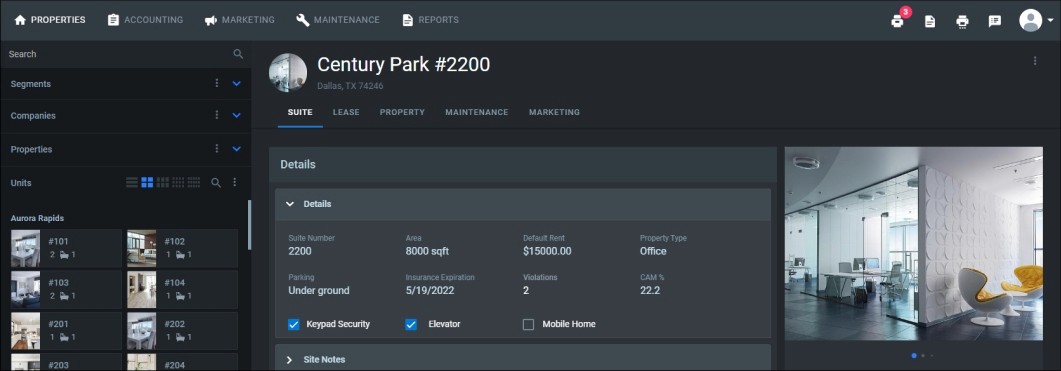Blog
4 2023 Trends in Commercial Property: What You Need to Know
Aug 16, 2023
A commercial property is any real estate that is used for business or income-generating purposes. This includes office buildings, retail spaces, and industrial warehouses. Unlike residential properties, commercial properties are primarily bought, sold, and leased for the purpose of conducting business activities.
Analyzing current commercial property trends is crucial for investors and property owners alike. Understanding the shift that’s going on in the market can help investors identify potential opportunities for growth and maximize their returns on investment. Staying updated on trends in commercial properties can also help property owners make informed decisions regarding leasing rates, property upgrades, and tenant retention strategies.
Current trends in commercial property management include the rise in coworking spaces, the increasing demand for sustainable buildings, and the growing popularity of mixed-use developments. Many of the changes in the industry have gained momentum in recent years making the job of property managers more challenging. This has given rise to the increased use of tools and technologies that make tasks more manageable. Keeping up with commercial property trends can help investors and property owners adapt their strategies to meet the evolving demands of the market.
1. Sustainability and Green Building Practices
There has been a steadily increasing emphasis on building practices that are sustainable and eco-friendly. This trend in commercial property is driven by a growing awareness of the environmental impact of buildings and a desire to reduce energy consumption and waste. These initiatives align with the idea of corporate social responsibility and also attract environmentally conscious customers and employees.
Many businesses are now seeking to lease or purchase commercial properties that have green certifications. The integration of recycled and eco-friendly materials as well as water conservation measures in the construction process has been gaining momentum. The incorporation of green spaces is also on the rise as they can be utilized by employees and customers while bringing a bit of nature into developed spaces.
These green initiatives don't just appeal to those interested in helping the environment. Sustainable buildings often have lower operating costs in the long run making them a financially attractive option for many businesses. The increasing demand for energy efficient buildings demonstrates this trend.
2. Technology Advancements Shaping the Industry
The advancements in technology have had a tremendous and far reaching impact on the property management industry. In the commercial property market technology has greatly improved the efficiency and effectiveness of operations. As technology continues to evolve we can expect even more innovative solutions that commercial tenants and landlords look for.
The adoption of smart building technologies such as automated lighting and temperature control systems have greatly improved energy efficiency in buildings. Advanced energy monitoring and management systems have been driving trends as well. These technologies allow for precise control and optimization of energy usage resulting in significant cost savings for property owners and tenants.
Enhanced security systems and internet connectivity allow property managers to remotely monitor and control access to the building. Additionally, internet connectivity enables property managers to easily communicate with tenants and address any concerns or maintenance issues in a timely manner. The integration of enhanced security systems and internet connectivity greatly enhances the efficiency and effectiveness of commercial property management.
Smart property management platforms, such as Property Matrix, provide the tools to monitor and control energy usage, optimize maintenance schedules, streamline operations, and enhance tenant comfort. Such software systems identify areas for further savings and operational improvements. These advancements are revolutionizing the property management industry.
3. Rise of Flexible Workspaces and Coworking
The evolution of remote work and its impact on commercial properties has led property managers to rethink the design and functionality of office spaces. With more employees working remotely, there is a greater focus on creating flexible and collaborative work environments that cater to the needs of both in-person and virtual workers. This has resulted in the rise of flexible workspaces and coworking spaces, which offer companies the ability to have a physical presence without the commitment of a long-term lease.
The popularity of these spaces has grown rapidly, with many property managers now incorporating them into their portfolios to meet the changing demands of the workforce. With the help of technology, property managers can efficiently manage and allocate resources in shared spaces, ensuring optimal utilization and maximizing profitability. This shift in the market has opened up new opportunities for property managers to diversify their portfolio and attract a wider range of tenants.
4. Development of Live-Work-Play Environments
Mixed-use developments have become increasingly popular, creating a demand for property managers who can oversee the integration of residential, commercial, and recreational spaces. By incorporating amenities such as fitness centers, restaurants, and entertainment venues, landlords can attract a diverse range of tenants who value convenience and an enhanced lifestyle. This transformation not only improves the overall appeal of a city but also presents property managers with new opportunities to expand their portfolios and cater to the evolving needs of modern professionals.
The economic benefits of mixed-use developments for businesses include increased foot traffic and customer base which lead to higher sales and revenue. Additionally, businesses in mixed-use developments can benefit from shared marketing and promotional activities as well as cost savings through shared resources and infrastructure. The close proximity to residential areas allows businesses to tap into a ready and captive market, providing a steady stream of customers and employees.
Analyzing current trends in commercial property management gives property managers and owners the ability to adapt to changing market conditions and consumer preferences. This can lead to increased tenant retention rates, higher occupancy levels, and ultimately greater profitability for property owners. Staying abreast of current commercial property trends allows property managers to identify and capitalize on new opportunities which is crucial for long-term success and profitability in the industry.




